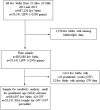Smoking Ban Law in Chile: Impact in Newborns' Birth Weight by Women's Age Groups and by City Population Density
- PMID: 36579137
- PMCID: PMC9791390
- DOI: 10.3389/ijph.2022.1605087
Smoking Ban Law in Chile: Impact in Newborns' Birth Weight by Women's Age Groups and by City Population Density
Abstract
Objectives: We examined the short-term impact of the Smoking Ban Law (SBL) enacted in Chile in 2013 on low birth weight (LBW) rates in cities and its differential effects by different maternal age groups and city density. Methods: We included 885,880 live births from 21 Chilean cities of ≥100,000 inhabitants. We examined the smoking and LBW prevalence distribution before and after the SBL. Through Poisson mixed effect models, we determined whether a meaningful change in LBW rate occurred after SBL implementation in the whole sample and stratified by city population density and maternal age group. Results: LBW prevalence remained stable before and after the SBL implementation (6.1% and 6.3%, respectively), while women's smoking prevalence had a relative reduction of 25.9% (p < 0.00001). No significant changes in LBW rate occurred after the implementation of SBL in the total sample or stratified by city density tertiles or maternal age groups. Conclusion: SBL implementation did not show short-term impact on LBW rate in Chile. Further studies need to examine long-term impact of SBL on low birthweight.
Keywords: Chile; Latin America; low birth weight; maternal & child health; smoke-free policy; tobacco.
Copyright © 2022 Valentino, Ortigoza, Rodriguez Osiac, Doberti, Mullachery and Nazzal.
Conflict of interest statement
The authors declare that they do not have any conflicts of interest.
Figures




References
-
- Araya C, Monge D, del Pilar M. REVISTA MEDICINA LEGAL DE COSTA RICA Efectos fetales y posnatales del tabaquismo durante el embarazo Fetal and postnatal effects of smoking during pregnancy. 2019;36(2).
-
- Davies JK, Bledsoe JM. Prenatal Alcohol and Drug Exposures in Adoption, 52. Pediatric Clinics of North America Pediatr Clin North Am; (2005), 1369–93. - PubMed
MeSH terms
Grants and funding
LinkOut - more resources
Full Text Sources

